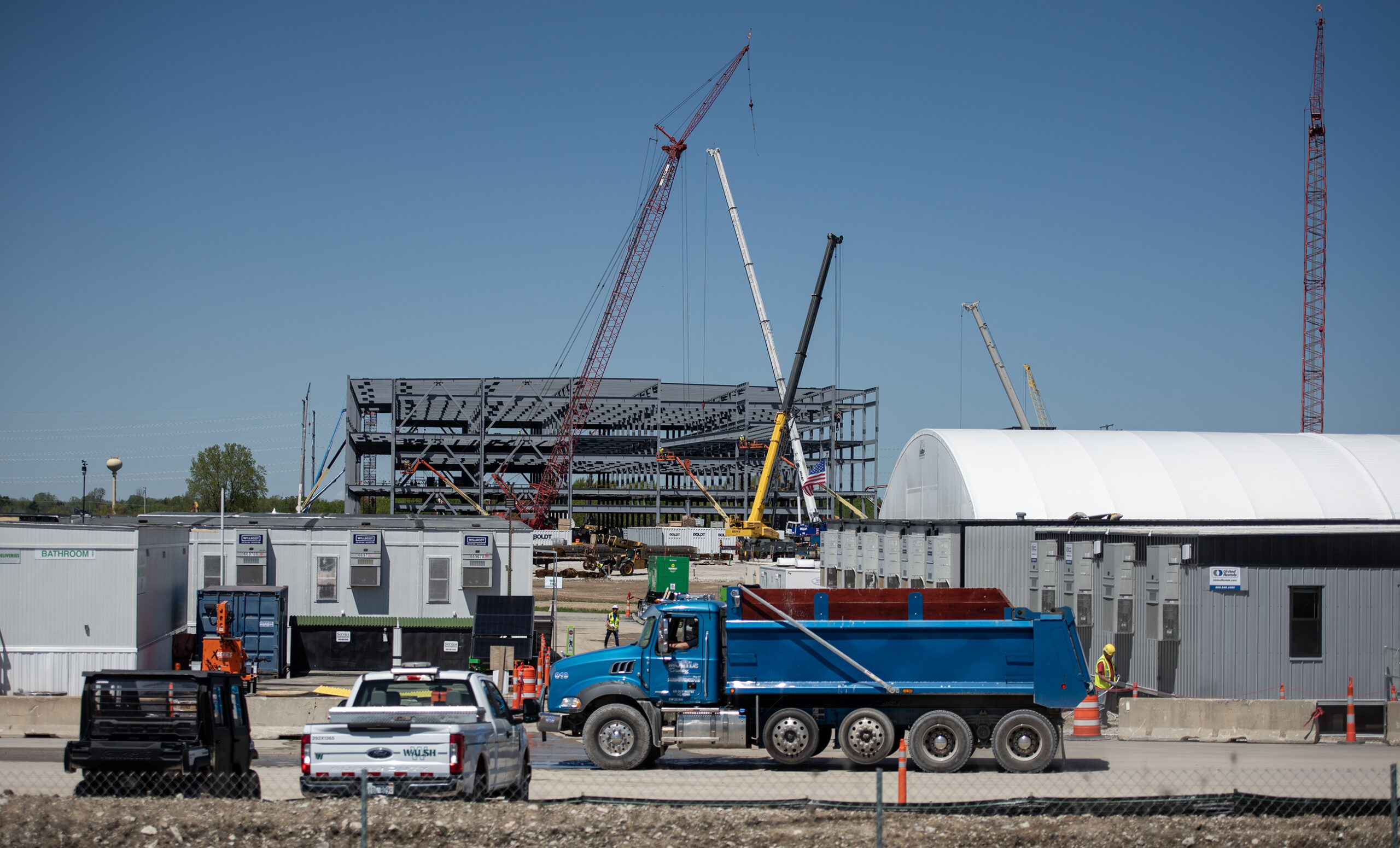A new data center could be coming to Beaver Dam as a flurry of similar projects across the state are raising concerns about whether utilities will be able to keep up with rising energy demand.
The city of Beaver Dam, Alliant Energy and the Beaver Dam Area Development Corp. have been working on a potential data center development for much of the last year, according to Trent Campbell, executive vice president of the Beaver Dam Area Development Corp.
The project would be located on a more than 500-acre site, called the Beaver Dam Commerce Park, that the city and Alliant Energy have been marketing for years.
Stay informed on the latest news
Sign up for WPR’s email newsletter.
The city has already formed a tax increment financing district to support the project, as well as approved development and water utilities agreements with a potential developer, Campbell said.
The developer is working through a limited liability company, Degas LLC. It’s registered to a Delaware firm that provides registered agent and compliance services to Fortune 500 companies.
“The entity we are working with is currently attempting to obtain non-local project approvals,” Campbell said in an email. “If they are successful in their efforts, all involved parties look forward to a future project announcement.”
A spokesperson for Alliant Energy said in a statement the utility is in the “exploratory and due diligence phases of a potential project.”
Last November, American Transmission Co. filed an application with state regulators for a distribution and interconnection project in Dodge County. In the application, ATC said it received an interconnection request from Alliant to “serve a new large load addition in the Beaver Dam area” associated with “a data center campus.”
It comes as Microsoft continues work on the first phase of a data center campus in Mount Pleasant and has plans for another data center complex in Kenosha. Other data centers have been proposed in Port Washington and Wisconsin Rapids.

Power-hungry data centers could balloon energy demand
Those projects could have a big impact on the state’s electric grid. Data centers are energy-intensive buildings that consume 10 to 50 times the energy per floor space of a commercial office building.
A spokesperson for Microsoft said the company anticipates the first phase of its Mount Pleasant project will require 450 megawatts. That’s enough energy to power roughly 300,000 homes.
“That new data center coming to Mount Pleasant is going to use more energy than all the homes in Dane County,” said Amy Barrilleaux, a spokesperson for the nonprofit Clean Wisconsin. “This is a scale of energy use unlike anything we’ve really ever seen.”
For comparison, a typical large industrial user in Wisconsin needs between 30 to 100 megawatts, according to the Wisconsin Industrial Energy Group, a nonprofit that advocates for large energy users.
Vijay Gadepally, a senior scientist at the MIT Lincoln Laboratory, said data centers use so much power because the computing equipment they house needs a lot of energy. He says some popular artificial intelligence platforms use 20 times the power of a desktop computer.
“There is a significant amount of energy that’s also spent to cool these processors because they need to stay usually somewhere between 60 to 80 degrees,” he said.
He said adding multiple data centers “absolutely will stress the local grid” if there’s no additional resources built to supply power.
“Something has to come onto the grid in order to power this,” he said. “You can’t just add a gigawatt or one and a half gigawatts of power consumption … and expect that the grid will adjust.”

Industrial groups increasingly concerned about grid
There’s growing concern among Wisconsin’s industrial users that the state could soon have insufficient capacity to meet demand for electricity.
That’s according to a 2024 filing with utility regulators from the Wisconsin Industrial Energy Group, the Midwest Food Products Association, the Wisconsin Cast Metals Association and the Wisconsin Paper Council.
“At the same time that we are watching electricity demand increase, Wisconsin utilities are dramatically reducing electricity capacity through the voluntary, premature retirement of baseload generation,” the industry groups wrote. “It appears that Wisconsin — or at least certain of its utilities — will have insufficient capacity to meet demand as early as 2025.”
The Midwest electric grid, which includes Wisconsin, is at “high” risk of power supply shortfalls in the coming years, according to a December 2024 report from the North American Electric Reliability Corp., a nonprofit grid watchdog. The report says the Midwest isn’t adding enough generation resources to keep up with coal plant retirements and demand growth.
We Energies, the state’s largest electric utility, is expected to have multiple data centers in its southeastern Wisconsin service area, including in Mount Pleasant, Kenosha and Port Washington.
Brendan Conway, a spokesperson for We Energies’ parent company, WEC Energy Group, said the Midwest grid operator requires utilities to have enough capacity to meet peak demand in both the summer and winter months.
He said the utility is confident it will be able to meet energy demand in the coming years. It expects that between 2025 and 2029 that energy demand will increase by about 20 percent from what’s currently in the system.
To boost reliability, he says We Energies currently has more than $2 billion in natural gas infrastructure projects awaiting approval from regulators, and WEC Energy Group plans to spend $9 billion on renewable energy projects by 2029.
“Whether you’re living in an apartment in Racine or you’re a large business somewhere in the northern part of the state, you want to make sure that when you need the energy, it’s there,” Conway said. “That’s our commitment. We’re going to make sure we can meet that commitment.”

Clean energy, ratepayer advocates critical of planned investments
Tom Content, executive director of the Citizens Utility Board of Wisconsin, said there’s a concern that utilities in the state could build too much infrastructure to meet demand projections.
“We’re in this really strange period where there’s a lot of hype, and we don’t know what’s the reality based on all the announcements, versus how many (data centers) will actually get built,” he said.
Right now, he says utilities across the Midwest are doing their best to attract data centers so they can profit from building infrastructure.
“The profits that the utilities are going to earn on those plants for years to come, it’s hundreds of dollars for each customer around the state — it’s real money,” Content said. “The risk is that we’re going to spend $2 billion, and possibly billions more, on natural gas plants that end up not being needed, and saddling customers with those costs too.”
Technological developments could make artificial intelligence more energy efficient. Bloomberg reports that a Chinese AI model appeared to achieve the same results as American models with a fraction of the energy use, triggering a selloff of U.S. power market stocks.
Even so, Barrilleaux, with Clean Wisconsin, said the pace that new data centers are being proposed in the state “feels very concerning” and has the potential to derail the state’s clean energy transition.
She said she believes that investing in more fossil fuels is the wrong way to go because new gas plants would have a life of about 30 years.
“That is something we cannot afford if we want to reach clean energy goals in Wisconsin,” she said. “This isn’t saying that AI and data centers are bad, but we do need to figure out what the impact is and how to handle it.”
Editor’s note: Alliant Energy and the Citizens Utility Board of Wisconsin are sponsors of Wisconsin Public Radio.
Wisconsin Public Radio, © Copyright 2025, Board of Regents of the University of Wisconsin System and Wisconsin Educational Communications Board.


